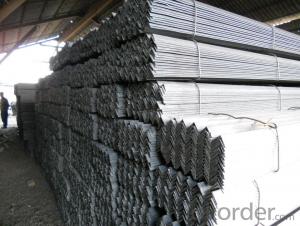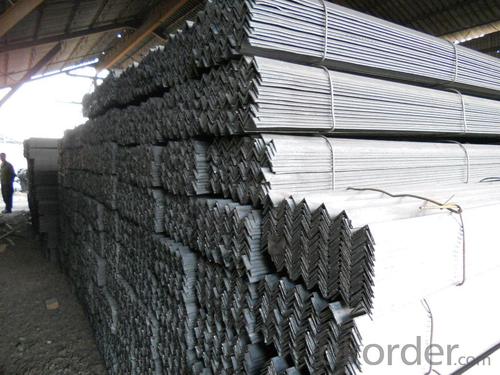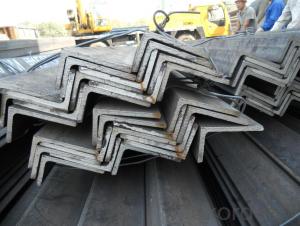Equal Steel Angle Q235
OKorder Service Pledge
OKorder Financial Service
You Might Also Like
Specifications of Equal Angle Steel
1.Standards:GB
2.Length:6m,9m,12m
3.Material:GBQ235 or Equivalent
4. Size:
Size (mm) | Mass (mm) | Size (mm) | Mass (mm) |
| 40*40*3 | 1.852 | 45*45*5 | 3.369 |
| 40*40*4 | 2.422 | 50*50*4 | 3.059 |
| 40*40*5 | 2.976 | 50*50*5 | 3.77 |
| 45*45*4 | 2.736 | 50*50*6 | 4.465 |
Usage & Applications of Equal Anlge Steel
Trusses;
Transmission towers;
Telecommunication towers;
Bracing for general structures;
Stiffeners in structural use.
Packaging & Delivery of Equal Angle Steel
1. Transportation: the goods are delivered by truck from mill to loading port, the maximum quantity can be loaded is around 40MTs by each truck. If the order quantity cannot reach the full truck loaded, the transportation cost per ton will be little higher than full load.
2. With bundles and load in 20 feet/40 feet container, or by bulk cargo, also we could do as customer's request.
3. Marks:
Color mark: There will be color marking on both end of the bundle for the cargo delivered by bulk vessel. That makes it easily to distinguish at the destination port.
Tag mark: There will be tag mark tied up on the bundles. The information usually including supplier logo and name, product name, made in China, shipping marks and other information request by the customer.
If loading by container the marking is not needed, but we will prepare it as customer request.
*If you would like to get our price, please inform us the size, standard/material and quantity. Thank you very much for your attention.
- Q: Can steel angles be used in seismic-resistant structures?
- Yes, steel angles can be used in seismic-resistant structures. Steel angles are commonly used as structural elements in buildings and bridges due to their high strength and versatility. In seismic-resistant structures, steel angles can be utilized in various ways to enhance the overall structural integrity and resistance to earthquakes. Steel angles can be used as bracing elements in seismic-resistant structures. By connecting steel angles diagonally between different structural components, they can help to distribute and dissipate seismic forces, reducing the overall impact on the structure. This helps to prevent excessive deformation or collapse during an earthquake. Additionally, steel angles can be used to reinforce and strengthen key components of the structure. For example, they can be welded or bolted to the beams and columns to provide additional support and stiffness. This reinforcement helps to withstand the lateral forces generated by earthquakes, improving the overall seismic performance of the structure. Moreover, steel angles can be employed in the construction of moment-resisting frames, which are widely used in seismic-resistant structures. In these frames, steel angles are used as the main components to create rigid connections between beams and columns, allowing them to transfer and distribute seismic forces effectively. This design strategy helps to minimize structural damage and provides better resistance to earthquakes. It is important to note that the use of steel angles in seismic-resistant structures should comply with relevant building codes and regulations. The specific design and detailing requirements may vary depending on the seismic zone and the magnitude of potential earthquakes. Therefore, it is crucial to consult with structural engineers and adhere to the appropriate guidelines to ensure the safe and effective use of steel angles in seismic-resistant structures.
- Q: Can steel angles be used in the construction of airport terminals?
- Yes, steel angles can be used in the construction of airport terminals. Steel angles are commonly used in structural applications because of their strength and durability. They can be used for framing, support, and reinforcement in various structural elements of airport terminals, such as columns, beams, and trusses.
- Q: How do you reinforce a steel angle?
- Depending on the specific application and requirements, there are various ways to reinforce a steel angle. Here are a few commonly used techniques: 1. Welded Plates: To enhance the strength of a steel angle, welded plates can be added at critical points. These additional plates are typically made of the same or stronger steel and are welded to the flanges or web of the angle. This method improves the overall rigidity and load-bearing capacity of the angle. 2. Gusset Plates: An alternative effective method for reinforcing a steel angle involves using gusset plates. These plates usually have a triangular shape and are welded to the flanges or web of the angle. By distributing forces more evenly across the angle, gusset plates increase its strength and resistance to bending or twisting. 3. Bracing: Bracing is a technique that involves adding extra steel members to reinforce a steel angle. These members can be directly connected to the angle or attached using welded or bolted connections. Bracing effectively enhances the angle's resistance to lateral or torsional forces and improves its overall stability. 4. Composite Materials: In certain cases, composite materials can be utilized to reinforce a steel angle. Fiber-reinforced polymers (FRPs) or carbon fiber reinforced polymers (CFRPs) can be wrapped around or bonded to the angle, providing added strength and stiffness. These composite materials significantly enhance the angle's load-carrying capacity and resistance to corrosion. To determine the most suitable method for reinforcing a steel angle in a specific application, it is essential to consult a structural engineer or a professional with expertise in steel structures. The chosen reinforcement technique must take into account the expected loads, the angle's geometry, and the desired level of reinforcement.
- Q: Can steel angles be used in the construction of staircases?
- Indeed, staircases can be constructed using steel angles. Due to their strength and versatility, steel angles are frequently employed as structural elements in construction. In the context of staircases, steel angles serve to offer support and stability to the entire structure. They can establish the framework for the stairs, providing support for the treads and risers. Moreover, steel angles can serve as handrails or guardrails, ensuring a firm and safe grip for users. All in all, steel angles are a favored option for staircase construction due to their durability, capacity to bear loads, and aesthetic attractiveness.
- Q: How do steel angles perform under lateral or wind loading conditions?
- Steel angles are commonly used in construction for their ability to withstand lateral or wind loading conditions. Due to their shape and structural design, steel angles offer excellent resistance against bending and twisting forces. They distribute the applied loads efficiently, ensuring stability and minimizing any potential structural damage. Overall, steel angles are reliable and perform exceptionally well under lateral or wind loading conditions.
- Q: What is the typical corrosion rate of steel angles?
- The typical corrosion rate of steel angles can vary depending on several factors such as the environmental conditions, the type of steel used, and the presence of any protective coatings. In general, steel angles are susceptible to corrosion due to their iron content. However, with proper maintenance and the application of protective measures, the corrosion rate can be significantly reduced. In mild atmospheres or indoor environments with low humidity and minimal exposure to corrosive agents, the corrosion rate of steel angles can be relatively low, typically ranging from 0.1 to 0.5 mils per year (1 mil is equivalent to 0.001 inches). This slow corrosion rate allows steel angles to maintain their structural integrity over an extended period. However, in more aggressive environments such as coastal areas with high salt content in the air or industrial settings with exposure to chemicals, the corrosion rate can be significantly higher. In these cases, the corrosion rate of steel angles can range from 0.5 to 2 mils per year or even higher. In such environments, it is crucial to implement measures like regular inspection, cleaning, and the application of protective coatings to mitigate the corrosion rate and prolong the lifespan of the steel angles. It is important to note that these corrosion rates are typical estimates, and actual rates may vary based on the specific conditions and factors mentioned earlier. Consulting with a corrosion engineer or utilizing corrosion rate data specific to the environment and steel type can provide a more accurate estimation of the typical corrosion rate for steel angles in a particular situation.
- Q: Are steel angles subject to deformation?
- Yes, steel angles are subject to deformation. Steel is a strong and durable material, but it is not immune to the forces that can cause deformation. Deformation can occur in steel angles due to various factors such as excessive loads, bending moments, temperature changes, and improper design or installation. When subjected to these forces, steel angles can experience bending, twisting, or warping, leading to a change in their original shape. To prevent or minimize deformation, engineers and designers can consider factors such as selecting the appropriate steel grade, calculating load capacities, and ensuring proper support and bracing.
- Q: How do steel angles compare to other materials like aluminum or wood?
- Steel angles have several advantages over other materials like aluminum or wood. Firstly, steel angles are known for their strength and durability. Steel is a highly robust material that can withstand heavy loads and high-pressure situations, making it ideal for structural applications. In comparison, aluminum is relatively weaker and less durable, making it better suited for lightweight applications. Secondly, steel angles have excellent fire resistance properties. Steel is non-combustible, which means it does not burn or contribute to the spread of fire. On the other hand, wood is highly flammable and can be a fire hazard in certain situations. Aluminum has a higher melting point than wood, but it does not possess the same level of fire resistance as steel. Moreover, steel angles have superior corrosion resistance compared to both aluminum and wood. Steel can be galvanized or treated with protective coatings to prevent rust and corrosion, making it suitable for outdoor or marine applications. Aluminum, although it has a natural oxide layer that resists corrosion, is still more susceptible to corrosion than steel. Wood, being an organic material, is highly vulnerable to rot and decay when exposed to moisture or insects. Another advantage of steel angles is their versatility. Steel can be easily fabricated and manipulated into various shapes and sizes, allowing for a wide range of design possibilities. Aluminum also offers some flexibility in terms of fabrication, but it is generally less malleable and more prone to cracking. Wood, while being relatively easy to work with, has limitations in terms of structural integrity and design flexibility. In terms of cost, steel angles are generally more economical than aluminum. Steel is widely available and has lower production costs, making it a cost-effective choice for many applications. Aluminum, on the other hand, can be more expensive due to higher production costs and its limited availability. Wood, depending on the type and quality, can vary in price but is often more affordable than steel or aluminum. In summary, steel angles offer superior strength, durability, fire resistance, corrosion resistance, versatility, and cost-effectiveness compared to materials like aluminum or wood. However, the choice of material ultimately depends on the specific application, design requirements, and budget constraints.
- Q: Can steel angles be used as reinforcement in concrete structures?
- Indeed, reinforcement in concrete structures can be achieved by utilizing steel angles. These angles, typically in the shape of L or angles, are inserted into the concrete to bolster its strength and provide support to the structure. By resisting tensile forces, these angles effectively prevent concrete from cracking or failing. They find extensive use in various applications like beams, columns, and walls, significantly enhancing the structural integrity and load-bearing capacity of these concrete components. Moreover, the ease with which steel angles can be welded or bolted together makes them a flexible and economical choice for reinforcing concrete structures.
- Q: Can steel angles be used for architectural detailing or ornamentation?
- Yes, steel angles can be used for architectural detailing or ornamentation. They are commonly used to add structural support, create unique design elements, and enhance the aesthetic appeal of buildings. Their versatility, strength, and durability make them suitable for various architectural applications.
Send your message to us
Equal Steel Angle Q235
OKorder Service Pledge
OKorder Financial Service
Similar products
Hot products
Hot Searches
Related keywords



























